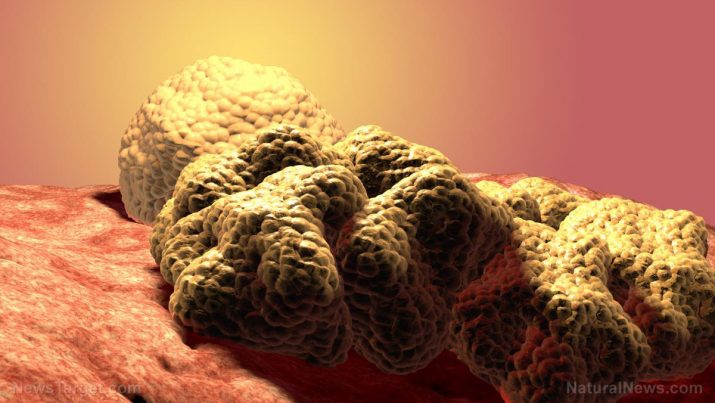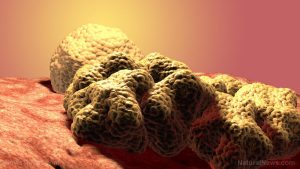
Basal cell carcinoma – causes, side effects and treatments at NaturalPedia.com
Wednesday, January 10, 2018 by Jhoanna Robinson
http://www.naturalpedia.com/basal-cell-carcinoma-causes-side-effects-and-treatments-at-naturalpedia-com.html

Basal cell carcinoma is the most common type of skin cancer. It is characterized by the appearance of tumors, which are locally invasive and which tend to burrow in but not metastasize on the face and neck, where the skin is exposed to sunlight.
Basal cell carcinoma can cause disfigurement, if one delays diagnosis and treatment and the cancer permeates local tissue. Among its risk factors include other forms of skin cancer such as melanoma and squamous cell carcinoma, which is also a skin cancer that is caused by the harmful rays of the sun; repeated prior episodes of sunburn; previous cutaneous injury, thermal burn, and diseases such as sebaceous naevus and cutaneous lupus; age and gender (it is prevalent in elderly males); Caucasian features (fair skin, blue eyes, and blond or red hair); inherited syndromes such as Bazex-Dupré-Christol syndrome, xeroderma pigmentosum, Oley syndrome, Gorlin syndrome and Rombo syndrome; and other pre-determining factors such as exposure to arsenic, immune suppression due to disease or medicines, and ionising radiation.
There is a possibility that basic cell carcinoma can recur after treatment. The characteristics of recurrent basal cell carcinoma include incomplete excision or narrow margins at primary excision; and morphoeic, infiltrative, and micronodular subtypes.
Metastatic basic cell carcinoma is another type of the disease. It requires multiple treatments and can be fatal.

Known side effects of basal cell carcinoma
Around 85 percent of basic cell carcinomas occur on the face, head, and neck. The other rarer cases appear on the extremities or on the hands. Basic cell carcinoma tumors can be characterized by erosion or ulceration (often central and pigmented); bleeding (especially when traumatized); oozing or crusted areas; teleangiectases (threadlike red lines or patterns on the skin) over the surface; and pearly appearance.
Body systems affected by basal cell carcinoma
Basic cell carcinoma is bad for the integumentary system.
Food items or nutrients that may prevent basal cell carcinoma
The nutrients that contribute to combating basic cell carcinoma include dietary fats, vitamin C, vitamin D, vitamin E, iron, zinc, carotenoids, copper, and retinol. Drinking black tea and green tea also helps.
Treatment, management plans for basal cell carcinoma
Several methods to treat basal cell carcinoma include electrodessication and curettage (administered using a needle-shaped electrode to heat the skin in precise areas), excisional surgery, photodynamic therapy, topical medications such as imiquimod and 5-fluorouracil, radiation, and Mohs surgery.
Excisional surgery is the most appropriate treatment method for infiltrative, morphoeic, and micronodular basic cell carcinomas. If a patient has very large lesions, flaps or skin grafts may be required.
Mohs surgery entails examining carefully marked excised tissue under the microscope, layer by layer, to guarantee complete excision. It is usually used in high-risk areas of the face such as around the eyes, nose, and lips. Undergoing this type of surgery ensures very high cure rates.
Superficial skin surgery includes electrocautery, shave, and curettage. This is a fast procedure requiring local anesthesia, without requiring the need for sutures. This type of surgery is done when the lesions are located on the limbs. The wound left by the surgery is usually left open to heal by itself, which it does within a few weeks’ time.
Cryotherapy is the method of treating a superficial skin lesion by freezing it with liquid nitrogen. It is not recommended for basic cell carcinomas found on the head and neck, and the knees. The result of the surgery is a blister that crusts over and heals within several weeks. Bad news, this surgery leaves a white mark on the skin of the patient where the carcinoma used to be.
Photodynamic therapy is a procedure wherein basic cell carcinoma is treated with a photosensitizing chemical, such as methyl aminolevulinate cream or aminolevulinic acid lotion. It is appropriate for low-risk, small basic cell carcinomas and not recommended for tumors that have a high risk of recurrence.
Where to learn more
- Eradicate Basal Cell Skin Cancer with These Inexpensive Topical Remedies
- 5 Questions to ask before buying sunglasses
- Organ Toxicity and Tattoo Ink
- Fight skin cancer through nutrition not sunscreen
- 5 Warning Signs of Skin Cancer You Should Not Ignore
Summary
Basal cell carcinoma is the most common type of skin cancer.
Basal cell carcinoma can cause disfigurement, if one delays diagnosis and treatment and the cancer permeates local tissue.
There is a possibility that basic cell carcinoma can recur after treatment.
Sources include:
Tagged Under: Tags: Basal cell carcinoma





